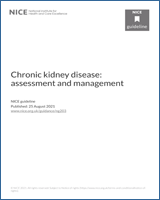All rights reserved. No part of this publication may be reproduced in any form (including photocopying or storing it in any medium by electronic means and whether or not transiently or incidentally to some other use of this publication) without the written permission of the copyright owner. Applications for the copyright owner’s written permission to reproduce any part of this publication should be addressed to the publisher.
NCBI Bookshelf. A service of the National Library of Medicine, National Institutes of Health.
National Collaborating Centre for Chronic Conditions (UK). Chronic Kidney Disease: National Clinical Guideline for Early Identification and Management in Adults in Primary and Secondary Care. London: Royal College of Physicians (UK); 2008 Sep. (NICE Clinical Guidelines, No. 73.)
This publication is provided for historical reference only and the information may be out of date.

Chronic Kidney Disease: National Clinical Guideline for Early Identification and Management in Adults in Primary and Secondary Care.
Show details12.1. Isolated invisible (microscopic) haematuria
12.1.1. Clinical Introduction
The presence of red blood cells in urine is termed haematuria. This may be visible to the naked eye (macroscopic) or invisible (microscopic). When haematuria is visible the urine is coloured pink or red. When the urine appears normal to the naked eye but the presence of red blood cells is detected by either reagent strip testing or microscopy, haematuria is termed invisible. The prevalence of asymptomatic invisible haematuria varies between 0.19 and 21%, depending on age and gender. Screening studies have suggested that the prevalence in the UK adult male population is around 2.5 %, increasing to 22 % in males over the age of 60 years.69,70 The differential diagnosis of invisible haematuria is wide, and includes urinary tract malignancy, urinary tract stones, urinary tract infection, and glomerulonephritis. Causes can be typically divided into urological and nephrological (see Table 12.1).
Table 12.1
Common causes of haematuria.
In the absence of a urological cause, haematuria can be presumed to be coming from the kidneys, most commonly as a result of one of the nephrological diseases listed above. However a firm diagnosis of most of these conditions (except the cystic diseases which are generally diagnosed radiologically) would require a kidney biopsy. This section is concerned with isolated invisible haematuria. This implies that at presentation there is no associated proteinuria, and that the GFR is normal (or if impaired there is no retrospective evidence of progressive loss of GFR). The challenge therefore is to decide a) how far to investigate the cause, and b) how people with isolated invisible haematuria should be monitored in the long term.
12.1.2. Methodology
Isolated invisible haematuria is defined as ≥3 erythrocytes per high power field in the urine without any other urine abnormalities (absence of infection or proteinuria). The clinical significance of isolated invisible haematuria was assessed with respect to morbidity and progression of CKD (declining GFR, development of proteinuria, progression to ESRD).
One prospective case series assessed renal functional decline in Japanese men (N=404) with confirmed isolated invisible haematuria (+1 result on a reagent strip and >5 RBC/hpf by microscopy) identified in a mass population screening between 1983 and 1996 in Hitachi, Japan, for a mean follow-up of 6.35 years.322
12.1.3. Health economics methodology
There were no health economics papers found to review.
12.1.4. Evidence statements
Development of proteinuria
In a case series, 9% of men with asymptomatic invisible haematuria developed proteinuria (defined as chronic nephritic syndrome) during follow-up.322 (Level 3)
Impaired renal function
0.7% of men with asymptomatic haematuria had a deterioration of renal function (serum creatinine >2.0 mg/dl) during follow-up. The renal function deterioration rate for asymptomatic haematuria was 3.0% over 10 years.322 (Level 3)
12.1.5. From evidence to recommendations
The GDG agreed that by definition isolated invisible haematuria meant that there was no associated proteinuria, the GFR was either normal or stable if below normal, that the kidney was macroscopically normal and that no urological disease was present. Apart from proteinuria there was no evidence that the people included in the study considered had had these other features excluded.
The GDG noted that when renal biopsies are undertaken in people with isolated invisible haematuria, the commonest abnormality identified is IgA nephropathy and that this condition is known to have the propensity to progress to end stage renal disease. In view of this they recommended that annual follow up should be undertaken.
The GDG agreed that if isolated invisible haematuria had been present and disappeared there was a low or non-existent risk of developing progressive CKD.
12.1.6. Recommendations
- R61.
When there is the need to differentiate persistent invisible haematuria in the absence of proteinuria from transient haematuria, regard two out of three positive reagent strip tests as confirmation of persistent invisible haematuria.
- R62.
Persistent invisible haematuria, with or without proteinuria, should prompt investigation for urinary tract malignancy in appropriate age groups.
- R63.
Persistent invisible haematuria in the absence of proteinuria should be followed up annually with repeat testing for haematuria, proteinuria/albuminuria, glomerular filtration rate (GFR) and blood pressure monitoring as long as the haematuria persists.
- Managing isolated invisible haematuria - Chronic Kidney DiseaseManaging isolated invisible haematuria - Chronic Kidney Disease
Your browsing activity is empty.
Activity recording is turned off.
See more...
